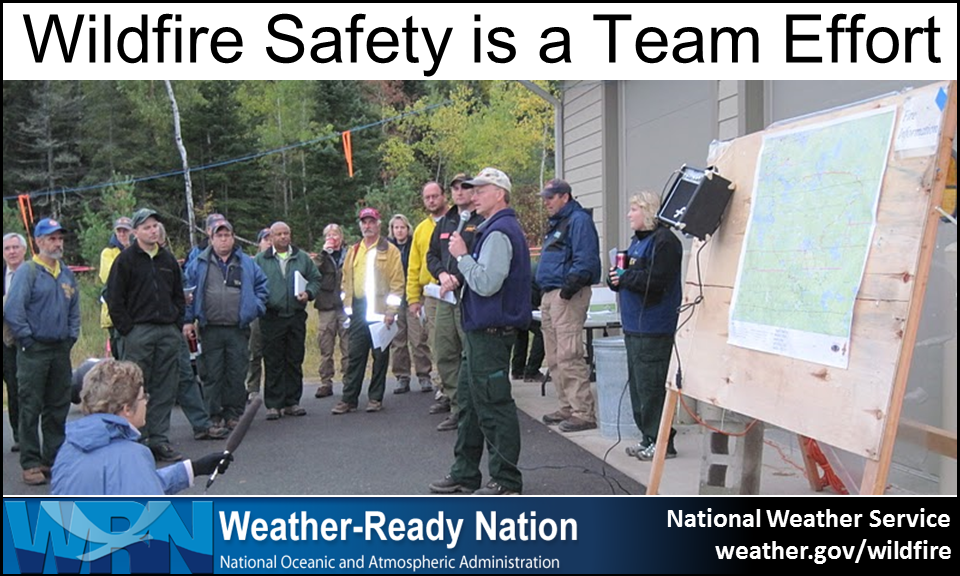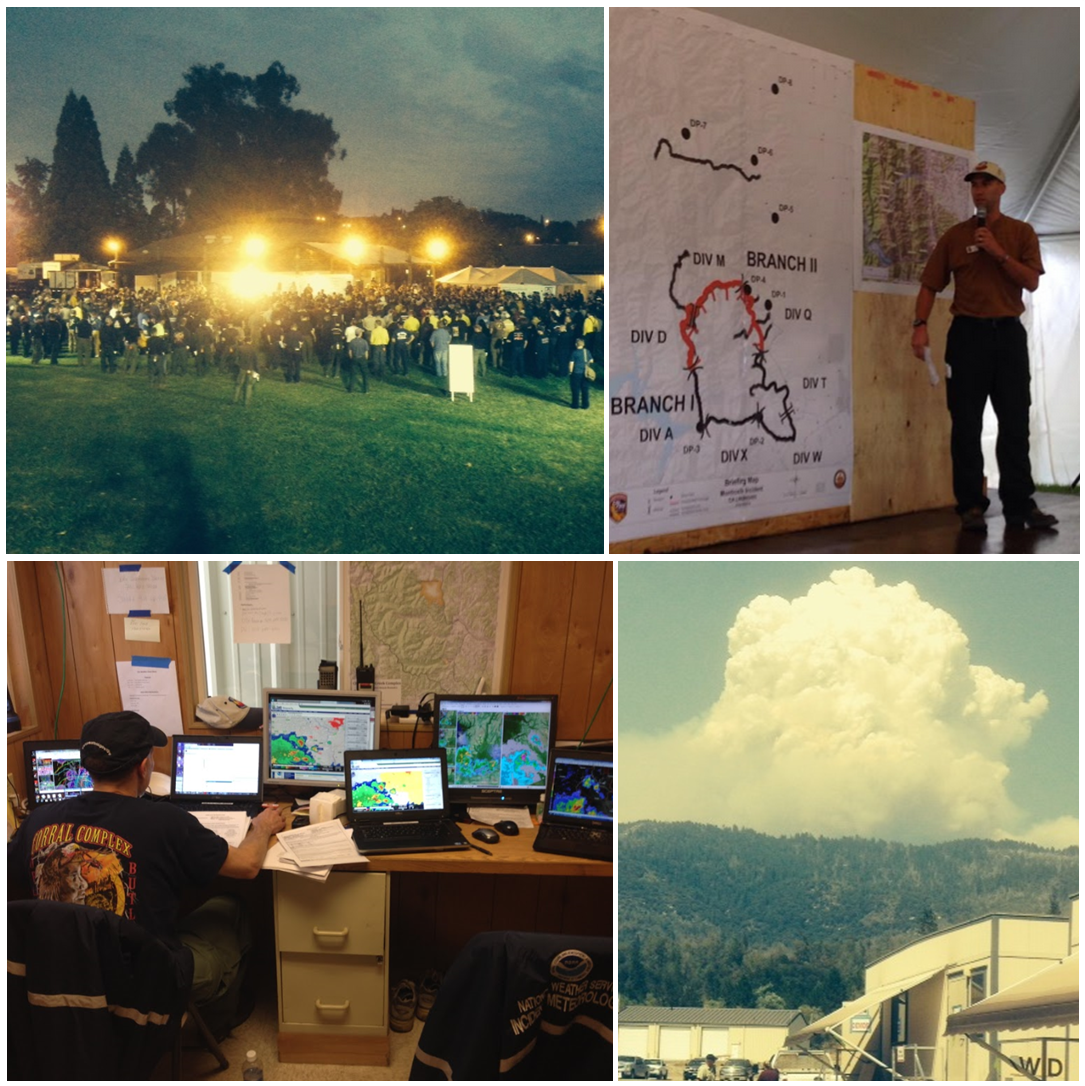Please help the National Weather Service spread these important safety messages on social media! Everyone is welcome to use the text and images provided below to help the NWS build a Weather-Ready Nation.
Facebook
Do you know what to do if you spot a wildfire? You should walk or drive away from the fire immediately and call 911 to report it! Weather conditions and the type of ground cover (trees, dry grass, etc) can make the fire change direction quickly so it is important that you stay far away from the blaze. Leaving the area will also make it easier for firefighters and rescue workers to get to the scene. Learn more at www.firewise.org #WildfireSafety
Twitter
Do you know what to do if you spot a wildfire? www.firewise.org #WildfireSafety

Facebook
In 2015, wildfires burned over 10,000,000 acres and destroyed 4636 structures, including 2638 homes, and were responsible for 13 deaths. Drier conditions in the fall season can fuel wildfires. Let’s do our part to keep this year’s totals well below those numbers. Be Ready, Be Firewise. http://www.nws.noaa.gov/om/fire/ready.shtml #WildfireSafety
Twitter
Drier conditions in the fall can fuel wildfires. Be Ready, Be Firewise. #WildfireSafety http://www.nws.noaa.gov/om/fire/ready.shtml

Facebook
Wildfire smoke can harm you in multiple ways. Smoke can hurt your eyes, irritate your respiratory system, and worsen chronic heart and lung diseases. Learn how you can protect your health and be safe if you are exposed to wildfire smoke. Photo courtesy of InciWeb. https://emergency.cdc.gov/disasters/wildfires/smoke.asp #WildfireSafety
Twitter
Learn how to protect yourself from wildfire smoke. https://emergency.cdc.gov/disasters/wildfires/smoke.asp #WildfireSafety

Facebook
During a wildfire, dust masks aren’t enough! They won’t protect you from the fine particles in wildfire smoke. It is best to stay indoors, keeping windows and doors closed. If you’re running an air conditioner, keep the fresh-air intake closed and the filter clean to prevent outdoor smoke from getting inside. https://www.airnow.gov/index.cfm?action=smoke.index #WildfireSafety
Twitter
Dust Masks aren’t enough to protect you from the wildfire smoke particles. https://www.airnow.gov/index.cfm?action=smoke.index #WildfireSafety

Facebook
Wildfire smoke is a mix of gases and fine particles from burning vegetation, building materials, and other materials. It can travel hundreds of miles and cause health concerns even for someone who is healthy. https://emergency.cdc.gov/disasters/wildfires/smoke.asp #WildfireSafety
Twitter
Wildfire smoke can travel 100s of miles and make anyone sick. https://emergency.cdc.gov/disasters/wildfires/smoke.asp #WildfireSafety

Facebook
NOAA's National Weather Service works with federal and state wildland managers to protect lives and property in and around America's wildlands. A visit to our Wildfire Safety site will help you prepare, be aware and act early if a wildfire comes your way. www.weather.gov/wildfire #WildfireSafety
Twitter
Be prepared, aware and act early if a wildfire comes your way. www.weather.gov/wildfire #WildfireSafety

Facebook
If you fly, we can’t! Drones near wildfires are not safe. Only authorized aircraft are permitted near wildfires. Let wildland firefighters do their job to keep the public safe. https://www.youtube.com/watch?v=06pz4GW7mY0 #WildfireSafety
Twitter
If you fly, we can’t! Drones near wildfires are not safe. https://www.youtube.com/watch?v=06pz4GW7mY0 #WildfireSafety

Facebook
Did you know that National Weather Service meteorologists work on-scene at large wildfires? These Incident Meteorologists (IMETs) go through extensive training and work in rough conditions to support wildfire fighting and containment operations. Learn what it’s like for an IMET working a wildfire: www.nws.noaa.gov/com/weatherreadynation/imet_article.html #WildfireSafety
Twitter
Did you know that @NWS Meteorologists work on-scene at large wildfires? www.nws.noaa.gov/com/weatherreadynation/imet_article.html #WildfireSafety

Facebook
Your family may not be together when a disaster strikes so it is important to plan in advance: how you will get to a safe place; how you will contact one another; how you will get back together; and what you will do in different situations. Create a Family Communications Plan. https://www.ready.gov/make-a-plan #WildfireSafety
Twitter
Your family may not be together when a disaster strikes. Make a plan https://www.ready.gov/make-a-plan #WildfireSafety

Facebook
During wildfire season, visit AirNow to get the Air Quality Index in your area. Wildfire smoke contains microscopic particles that can get into your eyes and respiratory system, where they can cause health problems such as burning eyes, runny nose, and illnesses such as bronchitis. https://www.airnow.gov/index.cfm?action=airnow.main #WildfireSafety
Twitter
During wildfire season, stay healthy. Get the Air Quality Index in your area. https://www.airnow.gov/index.cfm?action=airnow.main #WildfireSafety
